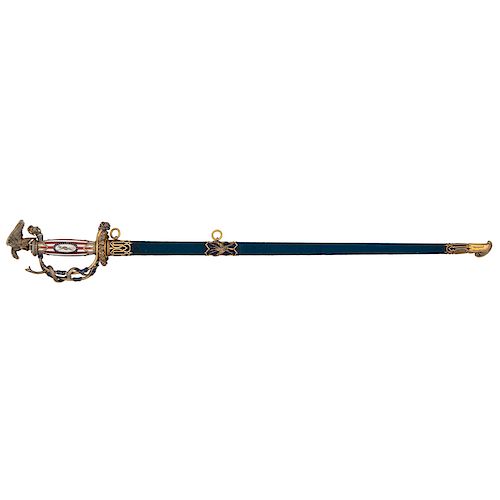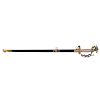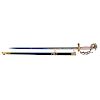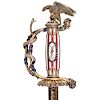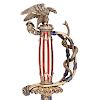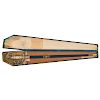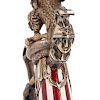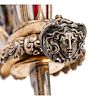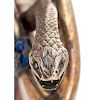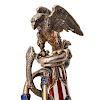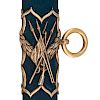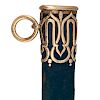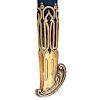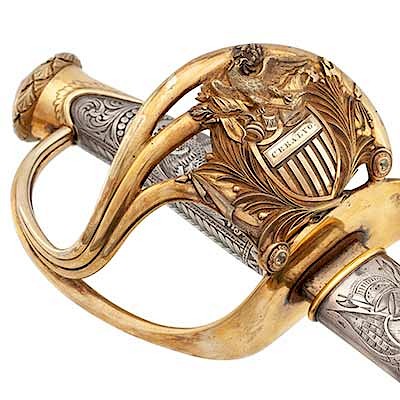Tiffany Presentation Sword to Schuyler Hamilton by the Citizens of New York
About Seller
6270 Este Ave.
Cincinnati , OH 45232
United States
With offices in Cincinnati, Cleveland and Denver, Cowan’s holds over 40 auctions each year, with annual sales exceeding $16M. We reach buyers around the globe, and take pride in our reputation for integrity, customer service and great results. A full-service house, Cowan’s Auctions specializes in Am...Read more
Two ways to bid:
- Leave a max absentee bid and the platform will bid on your behalf up to your maximum bid during the live auction.
- Bid live during the auction and your bids will be submitted real-time to the auctioneer.
Bid Increments
| Price | Bid Increment |
|---|---|
| $0 | $25 |
| $500 | $50 |
| $1,000 | $100 |
| $2,000 | $250 |
| $5,000 | $500 |
| $10,000 | $1,000 |
| $20,000 | $2,500 |
| $50,000 | $5,000 |
| $100,000 | $10,000 |
About Auction
Oct 30, 2018
Cowan's is honored to present the Magnificent Sword Collection of William Koch in its two-day firearms, militaria, and American history auction, with a focus on the Civil War. Cowan's Auctions dawnie@cowans.com
- Lot Description
Tiffany Presentation Sword to Schuyler Hamilton by the Citizens of New York
30.25" spear point, double-edged blade with 20.5" stopped median fuller. 8.25" hilt, including the massive spread-winged eagle pommel cap. Blade blued with gilt decorations including panoplies of arms, as well as foliate and geometric scrolls with the battle names MONTEREY in the obverse fuller and MIRAFLORES in the reverse fuller. Exquisitely cast silver washed hilt with martial, classical and foliate themes, including the face of Medusa on the top of the upper quillon, Mercury wearing his winged helm as the upper quillon at the rear of the hilt, and a large spread-winged American eagle as the pommel cap. The two-branch knuckle bow is further decorated with a serpent entwined in the guard. Additional decorations of blue enamel are present on the guard and knuckle bow. Oval grip with alternating bands of white and red enamel. Obverse grip with oval plaque showing stacked arms, surrounded by a blue enamel oval with gold gilt stars. Sword is accompanied by its original blue-baize covered wood scabbard with open work brass mounts and drag with the middle mount in the form of panoplies of arms. Sword is contained in its original semi-coffin-shaped wood case with a silver washed presentation plaque on the lid that reads: Excelsior Presented to Schuyler Hamilton, Brevet Captain of the United States Army and Aid de Camp of GENL. SCOTT, as a slight Testimony of the admiration and respect of his fellow citizens and friends of New York for his distinguished gallantry and conduct throughout the Mexican War, particularly at Monterey and Mira Flores for which he twice received the honours of promotion, and was appointed AID to his Commander in Chief; that veteran Judge of Military merit and Soul of Honour, WINFIELD SCOTT, General in Chief of the Army of the United States and Conquerer of Mexico. New York, November 1848 . Case with a blue fabric covering and satin and velvet lining.
Schuyler Hamilton (1822-1903), a grandson of Alexander Hamilton, remains an relatively obscure regular officer wounded twice and twice brevetted for gallantry during the Mexican War, later serving competently for a short time during the Civil War as brigadier general of volunteers. Born in New York City on July 25, 1822, Hamilton was just 15 when he entered West Point in 1837 graduating 24th in the Class of 1841 and duly commissioned as second lieutenant, 1st Infantry on July 1 1841. His early service included routine frontier duty at Fort Atkinson, Fort Crawford, and Jefferson Barracks before returning to the Military Academy as assistant instructor of infantry tactics for six months over 1844-45. An unreported illness then compelled Hamilton to take a leave of absence in 1845-46 prior to rejoining his regiment on the eve of the Mexican War. The 1st Infantry, formerly commanded by Zachary Taylor, was assigned to the general's Army of Occupation in Texas that advanced across the Rio Grande, taking a prominent role in the storming of Monterey where Lieutenant Hamilton was severely wounded with a skull fracture and a gunshot to the abdomen on September 21 during brutal house to house fighting. Two days later Hamilton was brevetted first lieutenant for "gallant and meritorious conduct" at Monterey. Hamilton's wound necessitated a lengthy recovery and the officer did not return to duty as regimental quartermaster for nearly a year during which time he was sidelined from duty by intermittent sick leave. He was fortuitously assigned as aide-de-camp to General Winfield Scott on April 30, 1847 and served in this special capacity for the rest of the war. Within the year Lieutenant Scott would received another dangerous wound, this time pierced by a Mexican lance at a little known skirmish on the road to Mexico City known as Mil Flores. On August 13, 1847, Lieutenant Hamilton was accompanying a detachment of dragoons assigned as General Scott's escort when "they attacked a superior force of Mexican cavalry and routed it." During the brief fight Hamilton was attacked and the lance "entered between the should blades and came out under the left breast" leaving the lance point fixed in Hamilton's upper body, detached from the broken shaft. It is documented that the lance was "pried out breaking two ribs." Hamilton was brevetted captain for "gallantry" at Mil Flores on August 13, 1847 and hospitalized. He did not see any further duty before the fall of Mexico City in September 1847 ended hostilities. In November 1848, Captain Hamilton receive this singular if not ostentatious presentation sword "as a slight Testimony of the admiration and respect of his fellow citizens and friends of New York." Similarly, the finely etched inscription also composed lavish praise for General Scott, lionizing him as "that veteran Judge of Military merit and Soul of Honour...and Conqueror of Mexico." After the war Captain Hamilton served as secretary to the Board of Commissioners of the Soldiers' Home in Washington, D.C. during 1852-54, while retaining his intimate position as aide-de-camp to the "Conqueror of Mexico" for more than six years until September 1, 1854. Hamilton found time to author a book in 1854 titled "History of the American Flag." Captain Hamilton resigned from the army on March 31, 1855 while posted to San Francisco and, rather surprisingly in light of his health, took up the position of Administrator of the new Almaden Quicksilver Mine. Like many who had preceded him, the lure of a quick fortune in faraway California would elude Hamilton. At some point during 1858 he purchased land in Branford, Connecticut and took up the pastoral work of a gentleman-farmer, a decision perhaps influenced by a lifetime of poor heath compounded by the lingering effect of two wounds.
When the Civil War broke out farmer Hamilton volunteered for service as a private in the 7th Regiment New York National Guard, a socially prominent militia unit that double-timed to Washington, D.C. in defense of the Capitol. He served only long enough to rejoin General Scott in Washington in the rank of lieutenant colonel of staff with the lofty appointment as Military Secretary to the General-in-Chief, from May 9, 1861. Hamilton undoubtedly acted as the general's confidant in this highly sensitive role leading up to Bull Run, conveying the General-in-Chief's thoughts to the Secretary of War, while being party to Scott's personal discussions and correspondence with President Lincoln. Lieutenant Colonel Hamilton became an insider among the President's 'war council' and gate-keeper of Scott's daily schedule, and in so doing he undoubtedly was party to the details of the Generalissimo's Anaconda Plan, broadly to strangle and cut the South in half thought blockade and control of the Mississippi River. Hamilton was advanced to staff colonel with the rather less grandiose title of aide-de-camp to General Scott on August 7, 1861. The cataclysmic events of the Civil War ruined many a military career, and the Generalissimo of the United States Army drilled into fighting shape during the War of 1812 -"Those are regulars, by God" - with fifty-three years in uniform, was not exempt. "Old Fuss and Feathers" at 75 years of age, proud and irascible", shouldered the ultimate blame for the disaster at Bull Run and graciously requested retirement on October 31, 1861 following the President's decision to put McClellan in command of the army. Colonel Hamilton fared well, accepting a commission to brigadier general November 12, 1861. If army nepotism was rampant, then Hamilton capitalized, and soon joined the staff of his brother-in-law Henry Halleck, then commanding the Department of Missouri in St. Louis. In January 1862, Brigadier General Hamilton took the field in command a division under Major General John Pope and successfully engaged in operations on the upper Mississippi against New Madrid and Island No. 10 resulting in its capture on April 7, 1862. Hamilton then led the left wing of the Army of the Mississippi during Halleck's much criticized "sluggish" advance and siege of Corinth during the spring of 1862. The general apparently had contracted malaria and took seriously ill during operations on May 9, and relied on his staff officers while quietly staying on duty. Hamilton finally requested sick leave on June 12. In July 1862 his surgeon "reported that General Hamilton had been suffering from typhoid fever that resulted in chronic diarrhea," among other disorders. While on sick leave in New York City throughout the summer and fall, Hamilton received word that he had been appointed major general of volunteers to rank from September 17, 1862 in recognition of his service at Island No. 10. Compelled by the promotion, Hamilton finally return to duty at Nashville in November 1862 and reported to General Rosecrans for assignment. His health clearly having incapacitated him from field service, Rosecrans had to order Hamilton home for medical care on December 14. Treated in New York City during January-February 1863 the attending surgeon later stated that "Hamilton had chronic dysentery, chronic enteritis, and impeded circulation of the liver..." In light of the unfavorable diagnosis, Hamilton - with no chance of being cleared for command - was forced to resign from the army on February 27, 1863. President Lincoln had graciously published in orders a message expressing "much regret." Hamilton's nomination as major general was never officially confirmed by the senate. In later years, he "felt that he had been dealt an injustice" and pressed for the rank in regards to his status on the retired list. Hamilton returned to farming in Branford, Connecticut until 1866, when, in spite of ongoing health issues, he found employments as a Hydrographic Engineer in New York City throughout the 1870's. Schuyler Hamilton's longevity - he lived in Connecticut and New York for another 30 years - belie the many documented reports of his chronic poor health. He finally died on March 18, 1903 in New York City and was buried with little public acclamation in Greenwood Cemetery, Brooklyn.Fine. Blade retains much of the blued and gilt finish, with some minor wear and freckled loss. Hilt with strong traces of thinned silver. Blue enamel with some wear and loss, grip with some repairs to the enamel as well, most obviously on the reverse. Eagle pommel cap slightly loose. Scabbard with some wear and fabric loss, particularly along the edges. Case fair to good with significant wear, some cracks and structural issued. Covering with loss to the fabric, which has mostly faded to gray. Much of the lower lining is missing on the interior.Condition
- Shipping Info
-
Buyers are required to pay for all packing, shipping and insurance charges. Overseas duty charges are the responsibility of the successful Bidder. Be aware that for larger and/or valuable items, shipping charges can be substantial. - If there is no shipping amount on listed your invoice, you will need to make arrangements to pick up or ship your purchase through an alternative shipping company. Our shipping department can be contacted at 513.871.1670 (ext. 219) or email shipping@cowans.com. - Shipping charges include insurance for your order while in transit. If you have private insurance we will adjust your charge to include only packing and shipping. - Please allow 14 – 21 days after payment to package and ship your purchase as carefully as possible.
-
- Buyer's Premium



 EUR
EUR CAD
CAD AUD
AUD GBP
GBP MXN
MXN HKD
HKD CNY
CNY MYR
MYR SEK
SEK SGD
SGD CHF
CHF THB
THB